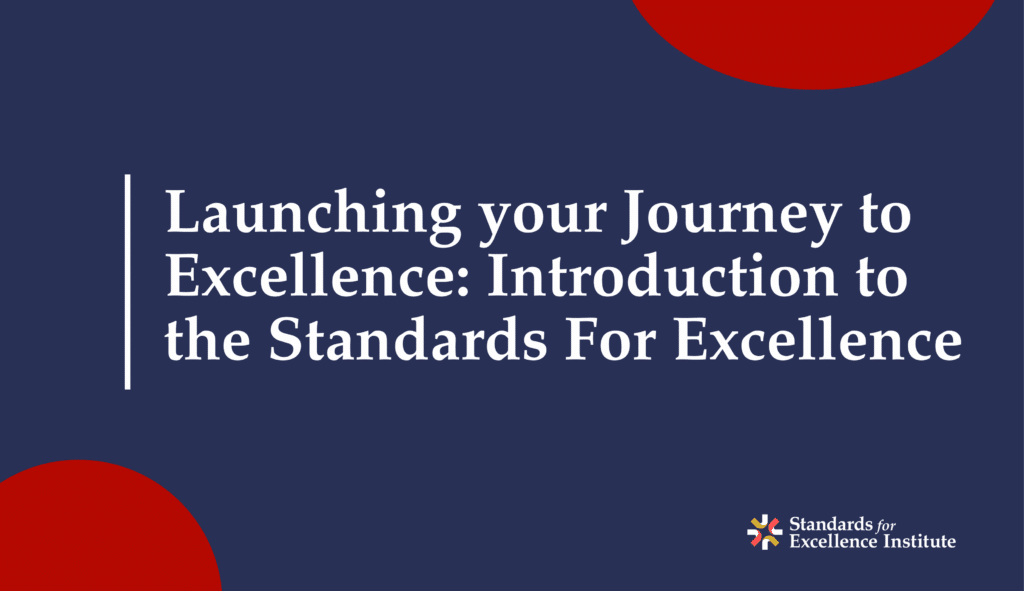
With Standards for Excellence Institute® resources, nonprofit organizations have measures in place to adapt to significant changes, making them more equipped to function effectively as times change.
Make sure that your organization is ready to embrace change using these 5 tips:
1. Make a compelling, supportive argument.
Staff members are more likely to accept a change when they can see that it is essential to the development and function of the organization. With certain changes, especially those in technology and software, it’s difficult for staff members to grasp the importance of the change. Inspire your staff to embrace the change by showing them that you just can’t function without it!
The Standards for Excellence® Code identifies specific benchmarks and measures that provide objective standards and best practices on how a nonprofit should operate. According to the code, “the executive is responsible for the day-to-day management and operations of the organization. The executive should be committed to the mission of the organization and have the skills necessary to manage the paid and volunteer talent, and financial resources of the organization.”
As an executive director you can combat resistance using data that proves changes are benefiting your organization in program reach and communication effectiveness, and with stories to show the positive impact the change is making in the community you serve. Putting a face to the change will compel staff, volunteers, and community members to embrace it.
You can show that the change is doing more than benefiting your organization’s internal function. It is helping you to fulfill your mission and serve your community more effectively.
2. Be a role model.
In uncertain times, we look to leaders to guide us into the unknown. Establish which key staff members are driving the change, as they will become the leaders that model the transition. If there is a change in technology, those who master the new system first will become a resource for those still catching onto it.
Ensure that executive directors and board members show interest in the change. If the leaders of the organization do not support the change, no one else will either! You can’t compel your staff to respect something without modeling that respect yourself.
3. Provide massive support.
Your staff will likely adjust to the change in a variety of ways. Provide an extensive support system so that your staff doesn’t feel abandoned in the transition. Often, more support is needed than we expect, so plan on providing more support than seems required. Provide helpful resources and emotional support to guide everyone along in the process. Holding the hands of your staff through a difficult process will help everyone to emerge more equipped, comfortable, and confident in the changes that were made.
Not everyone can admit when they are uncertain or confused with new changes. Allow extra time for adjustment, giving everyone a chance to catch up!
4. Acknowledge fears and doubts.
In conjunction with your established support systems, assure your staff that it is OK to feel insecure about unfamiliar territory! Shifting roles, staff rearrangement, and the redistribution of resources may leave employees feeling disconnected to their work, or useless in their new roles. Employees are especially sensitive to shifting roles and changes in staff structure. Unfortunately, colleagues may not readily respond to others’ new roles and power structures.
To combat these emotional consequences, pay attention to the existing social structure of your organization, and comfort team members when the norm is disrupted.
5. Plan extensively for the change.
Break larger goals into smaller, concrete steps. With this approach, when small goals are accomplished, we can celebrate mini-victories along the way! This boosts the mood of everyone involved and sheds a positive light on the transition process.
Additionally, predict problems before they arise. Issues with technology (problems with new software or a lack of training with new systems) and resistance from your team are very common. By acknowledging that these problems may come up, you can competently attack issues as they arise.
Finally, create your own definition of “done.” Track your organization’s progress towards the goal by remembering your original vision, resources used, and any milestones accomplished along the way. Then, when your team reaches the end goal, you can look back and feel accomplished about everything that was completed along the journey.
Then, establish a marker that will signify the official ending of the change. Without a specific ending point to mark the completion of the change, we lose interest and feel as if the goal is not complete. Combat this anxiety and unrest over unmet goals by establishing a finite, terminal end goal. Now, all that is left to do is celebrate the successful transition!

Rob Levit is a Standards for Excellence® Licensed Consultant.



